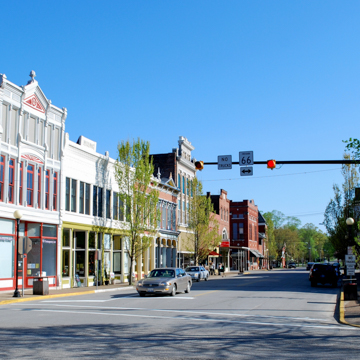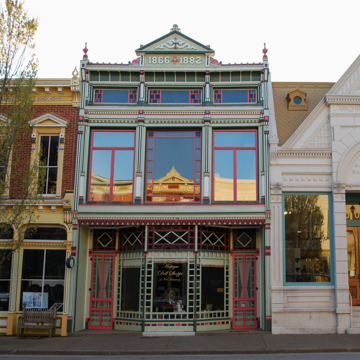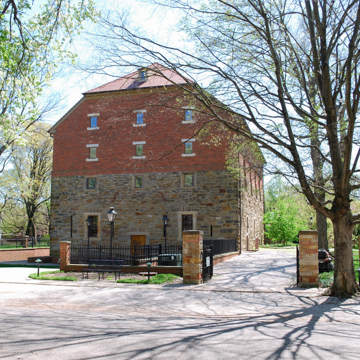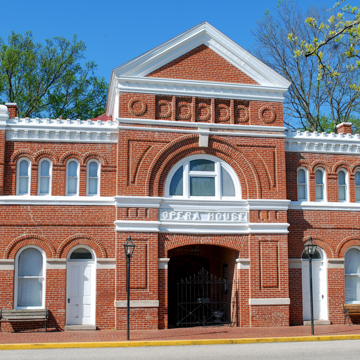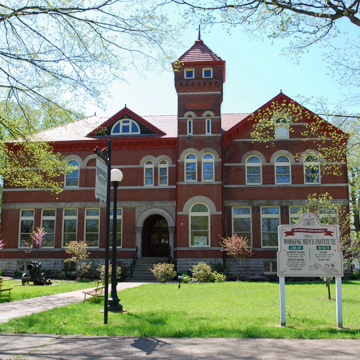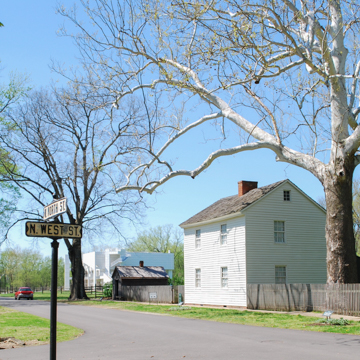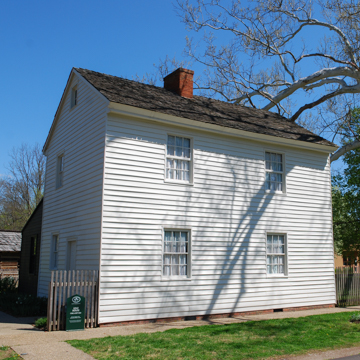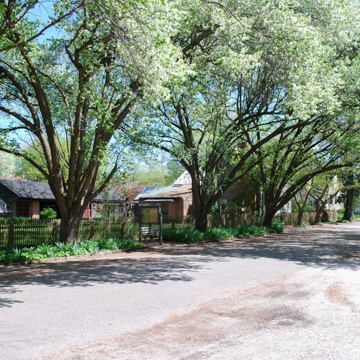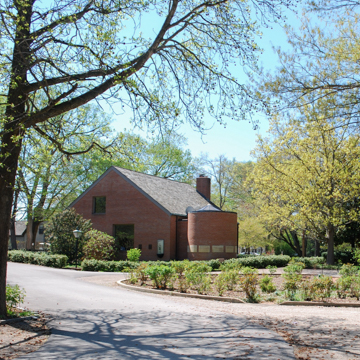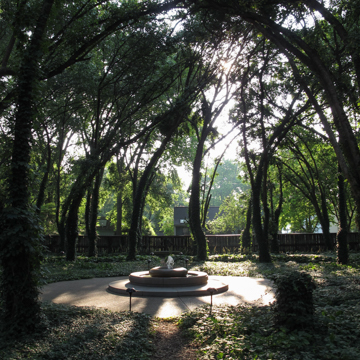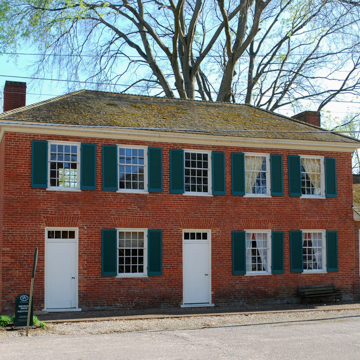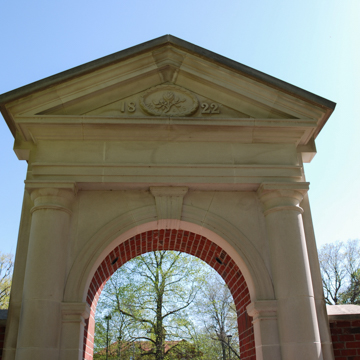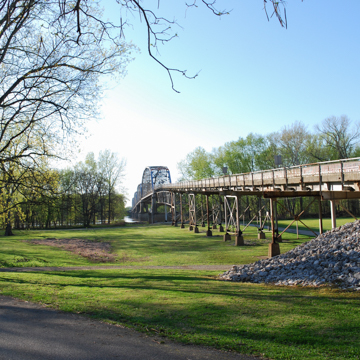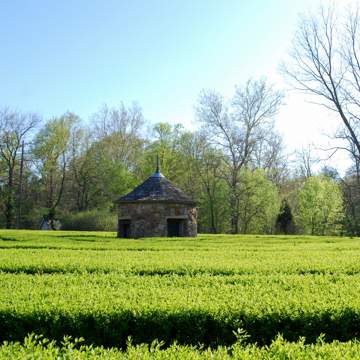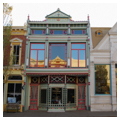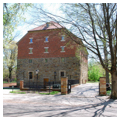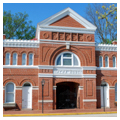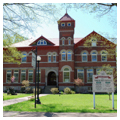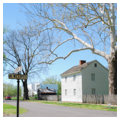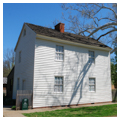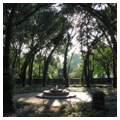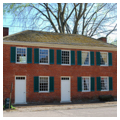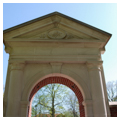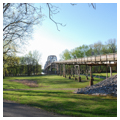New Harmony holds a unique place in America as having been at the center of two distinct nineteenth-century utopian experiments: the religious Harmonie Society, a millennialist sect established by German-born George Rapp, and the secular utopian experiment of Welshman Robert Owen. A religious expatriate, Rapp, part of volatile religious developments of the period, became the leader of a sectarian, Pietist group in the 1790s that identified faith outside of the established church. By the end of the eighteenth century, Rapp had upwards of 20,000 followers. Under watch of the German government and facing increased persecution, Rapp left for America in July 1803, arriving in Philadelphia three months later. The Harmonie Society was established in Butler County, Pennsylvania, in 1804, with nearly 500 members. Lasting just under a decade, the Harmonie Society was abandoned in 1814, in favor of a location with a more moderate climate and friendlier neighbors, which would be more conducive to the development of an expansive community. The seed for this community was planted in southwestern Indiana on the banks of the Wabash River, with 7,000 acres purchased for the second “Harmonie” or “New Harmonie” in May 1814. By 1817, the community of New Harmony encompassed 30,000 acres.
The vacant Indiana wilderness was quickly transformed with Rapp’s religious motives at the core. The community was laid out, and swamps drained. A first generation of log dwelling houses was replaced with two-story brick and frame dwellings, and a tavern, granary, mills, and churches were also constructed. By the time the last transport arrived in New Harmony, the community totaled 730 people. More than 180 structures were completed within ten years of the community’s founding, including dozens of dwellings, dormitories, stores, workshops, and mills, as well as a church, brewery, distillery, tannery, textile factory, and multiple other manufactories. Under the Harmonie Society’s Articles of Agreement—the document outlining the spirit of the community and the ethos by which members of the community agreed to carry out their lives—all real property was collectively owned by the Society, which provided housing for community members.
By 1824, the Harmonie Society faced numerous problems, including internal dissent, unfavorable conditions, and diminished business income resulting from the community’s distance from the eastern markets where the Harmonists sold their goods. Plagued with such problems, the Harmonie Society ceased to function in Indiana after 1824, when Rapp decided to return to Pennsylvania, where he established the community of Economy. Advertising the entire community of New Harmony for sale, inclusive of all land, buildings, and other improvements, Rapp found a buyer in Robert Owen, a successful manufacturer and owner of the New Lanark mills in Scotland. Owen had taken particular interest in bettering the lives of working men, women, and children in an era of questionable working conditions and limited opportunities, and in providing educational opportunities and limiting child labor. As was the case with Rapp, the community represented a new opportunity to achieve the perfect society for Owen, this time founded on scientific, educational, and philosophical pursuit, a direct departure from the religious aspirations of the Harmonists.
Stopping in New York, Philadelphia, and Washington, D.C. to make his ideas known, Owen eventually arrived in New Harmony in January 1825 to inspect the community and formally purchase it. The town would serve as the backdrop for a social experiment by Owen, which began with the arrival of a keelboat, the Philanthropist, in January 1826, so-named the “Boatload of Knowledge” because of the many scientists and educators that arrived to take part in Owen’s experiment. Such participants included, for example, William Maclure (1763–1840), president of the Academy of Natural Sciences of Philadelphia and known as the father of American geology; Thomas Say (1787–1834), an entomologist and conchologist; Gerard Troost (1776–1850), a Dutch geologist, mineralogist, zoologist, and chemist; Charles-Alexandre Lesueur (1778–1846), a naturalist, explorer, and artist; Josiah Warren (1798–1874), inventor, musician, and author; and Frances Wright (1795–1852), a lecturer, writer, freethinker, feminist, abolitionist, and social reformer.
Despite Owen’s idealistic approach, the community was overrun with problems, particularly conflicts between those who contributed to the greater good of the society and those who did not. In 1827, Owen left New Harmony, abandoning his experimental community. In 1828, the entirety of the town was transferred to William Maclure’s sole ownership, with him continuing to use the community for his educational experiments. Nine years later, in 1837, Maclure’s community also came to an end. At this point, the various properties went into private ownership for the first time as the post–communal era began.
In private ownership, the community of New Harmony continued to develop throughout the nineteenth century and into the twentieth century as new houses, churches, and schools were constructed and the commercial thoroughfare of Main Street matured. The next significant period of development came in the 1930s, with the beginnings of the New Harmony Memorial Commission and the state memorial at New Harmony in 1936. It was at this time—during a period of national reinvestment in history and civic pride—that Governor Township was approached by a group of concerned citizens regarding the preservation of the site. The group’s goals included protecting and preserving the remaining historic resources, promoting statewide recognition of New Harmony’s significance, and increasing tourism. The group was formalized in 1937 with an act of the Indiana General Assembly, which authorized the governor to appoint a seven-member commission “to make a survey and create plans whereby the state may take over and assume jurisdiction of certain units and areas in and about the town of New Harmony for permanent memorial purposes.” In short time, the appointed New Harmony Memorial Commission would get to work on its recommendations for the state memorial, which included acquisition and restoration of significant properties such as the Fauntleroy House, a circa 1818 Harmonist dwelling, and Community House No. 2, a circa 1822 Harmonist boarding house; memorialization of the Labyrinth, a circa 1815 nine-circuit hedge maze planted by the Harmonie Society; and development of educational programming and publications.
The Memorial Commission’s work continued throughout the 1940s and into the 1950s, except for a period of inactivity during World War II when funding was suspended. Ultimately, however, the Memorial Commission was dissolved in 1955 and management of the state memorial was transferred to the Indiana Department of Conservation, which began a period of reinvestment in the community. Notably, it was during this period of activity by the state that local proponent Jane Blaffer Owen began to make her mark. The wife of Kenneth Owen, petroleum geologist and great-great-grandson of Robert Owen, Jane first came to the town in 1941 with her husband amidst a brief oil boom. She observed the potential danger New Harmony faced in succumbing to inappropriate development and disregard for the community’s heritage. Desiring to preserve the significant components of New Harmony’s legacy but not leave it in stasis, Jane embarked on a substantial campaign of reinvestment founded in the progressive roots of the community. It was during this period that such iconic works as Philip Johnson’s Roofless Church and Richard Meier’s Atheneum, as well as Evans Woollen’s more subtle New Harmony Inn, were constructed, extending the architectural vocabulary of New Harmony.
The legacies of New Harmony are recognized in the community’s designation as a National Historic Landmark. Today, New Harmony continues to hold a unique place in history, rooted in the two utopian communities that once called the small riverfront town home. Amidst the landscapes crafted by the Harmonie Society and the Owen community are the legacies of multiple generations of preservationists who have sought to protect this rich heritage, from local forces such as Mary Emily Fauntleroy and Jane Blaffer Owen, to entities such as the New Harmony Memorial Commission and the State of Indiana, the latter of which continues to maintain a portion of the community as a state memorial unit, managed in cooperation with the Indiana State Museum and Historic Sites Corporation and the University of Southern Indiana.
References
Arndt, Karl J.R., ed. A Documentary History of the Indiana Decade of the Harmony Society, 1814-1824. Indianapolis: Indiana Historical Society, 1978.
Carmony, Donald F., and Josephine M. Elliott. “New Harmony, Indiana: Robert Owen’s Seedbed for Utopia.” Indiana Magazine of History 76, no. 3 (1980).
Hurdis, Jr., Frank, “New Harmony Historic District,” Posey County, Indiana. National Historic Landmark Nomination, 2006. National Park Service, U.S. Department of the Interior, Washington, D.C.
Lockwood, George Browning. The New Harmony Communities. Marin, IN: Chronicle Company, 1902.
New Harmony Memorial Commission. The New Harmony Memorial Movement. New Harmony, IN: New Harmony Memorial Commission, 1942.

